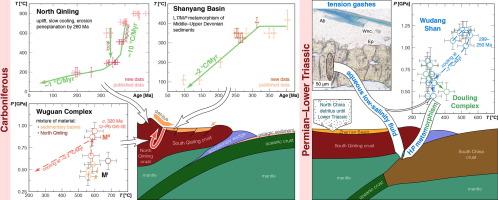Carboniferous–Triassic subduction in the Qinling orogen
IF 7.2
1区 地球科学
Q1 GEOSCIENCES, MULTIDISCIPLINARY
引用次数: 0
Abstract
The Qinling–Tongbai–Hong’an–Dabie–Sulu Orogen links two cratons, North China and South China, and records the reorganization and transfer of plates from Rodinia to Gondwana and Eurasia. The formation of North Qinling at the southern North China margin (524–378 Ma) by subduction–accretion processes and the collision between North and South China (270–190 Ma) are pivotal for this reorganization. We outline the geological processes that link both events by combining phase equilibria modeling, conventional thermobarometry, U–Pb (zircon, titanite, garnet–staurolite) and 40Ar/39Ar and Rb–Sr (amphibole, micas) geochronology. The North Qinling experienced transpressional reactivation of shear zones, local fluid percolation, and metamorphism up to the lowest amphibolite facies (≲ 550 °C) until 324 Ma; protracted uplift and erosion with slow cooling (1 °C/Myr) led to its peneplanation prior to 260 Ma. The southerly abutting Wuguan Complex underwent two consecutive metamorphic events: while the older was diverse (600–750 °C, 0.5–1.2 GPa), the younger had a regionally homogeneous peak (590 °C, 0.9 GPa) at c. 324 Ma. Subduction and early exhumation of the South China margin occurred at 299–250 Ma in East Qinling. During the exhumation, medium-grade blueschists (500 °C, 1.0–1.3 GPa) were imbricated with low-grade rocks (300 °C, 0.5–1.0 GPa). Subsequent extensional doming with percolation of a low-salinity, hydrous fluid and south-vergent thrusting brought these rocks to near-surface levels by 200 Ma. New and published data indicate that plate convergence governed geologic processes to the south of North China not only before 378 Ma but protractedly or episodically until 190 Ma. This prolonged history is inconsistent with the amalgamation of North China to Gondwana but substantiates paleogeographic reconstructions with North China as a Paleozoic island continent. Carboniferous–Triassic subduction in the Qinling ultimately led to the welding of North China and South China, completing their transfer from Rodinia to Eurasia.

秦岭造山带的石炭纪-三叠纪俯冲运动
秦岭-桐柏-红安-大别-苏禄造山带连接了华北和华南两大板块,记录了从罗迪尼亚到冈瓦纳和欧亚大陆的板块重组和转移。华北南缘的北秦岭(524-378Ma)由俯冲-喷发过程形成,华北和华南之间的碰撞(270-190Ma)是这一重组的关键。我们结合相平衡模型、传统热压测量、U-Pb(锆石、榍石、石榴石-陶土)和40Ar/39Ar及Rb-Sr(闪石、云母)地质年代学,概述了将这两个事件联系起来的地质过程。秦岭北麓在324Ma之前经历了剪切带的换位再造、局部流体渗流和变质作用,直至最低的闪长岩面(≲ 550 °C);长期的隆起和侵蚀作用以及缓慢的冷却(1 °C/Myr)导致其在260Ma之前发生了倒平面化。南侧毗邻的武关岩群经历了两次连续的变质事件:较早的变质事件具有多样性(600-750 °C,0.5-1.2 GPa),而较晚的变质事件则在约324 Ma时出现了一个区域性的同质峰值(590 °C,0.9 GPa)。华南边缘的俯冲和早期掘起发生在秦岭东部的299-250 Ma。在掘起过程中,中品位蓝晶岩(500 °C,1.0-1.3 GPa)与低品位岩石(300 °C,0.5-1.0 GPa)交错。随后,低盐度、含水流体的渗滤作用和南向推移作用使这些岩石在200Ma时达到近地表水平。新公布的数据表明,板块辐合不仅在公元前378年之前支配着华北南部的地质过程,而且一直持续到公元前190年。这一漫长的历史与华北与冈瓦纳大陆合并的说法不一致,但却证实了华北作为古生代岛屿大陆的古地理重建。秦岭石炭纪-三叠纪的俯冲最终导致了华北与华南的融合,完成了从罗迪尼亚向欧亚大陆的转移。
本文章由计算机程序翻译,如有差异,请以英文原文为准。
求助全文
约1分钟内获得全文
求助全文
来源期刊

Gondwana Research
地学-地球科学综合
CiteScore
12.90
自引率
6.60%
发文量
298
审稿时长
65 days
期刊介绍:
Gondwana Research (GR) is an International Journal aimed to promote high quality research publications on all topics related to solid Earth, particularly with reference to the origin and evolution of continents, continental assemblies and their resources. GR is an "all earth science" journal with no restrictions on geological time, terrane or theme and covers a wide spectrum of topics in geosciences such as geology, geomorphology, palaeontology, structure, petrology, geochemistry, stable isotopes, geochronology, economic geology, exploration geology, engineering geology, geophysics, and environmental geology among other themes, and provides an appropriate forum to integrate studies from different disciplines and different terrains. In addition to regular articles and thematic issues, the journal invites high profile state-of-the-art reviews on thrust area topics for its column, ''GR FOCUS''. Focus articles include short biographies and photographs of the authors. Short articles (within ten printed pages) for rapid publication reporting important discoveries or innovative models of global interest will be considered under the category ''GR LETTERS''.
 求助内容:
求助内容: 应助结果提醒方式:
应助结果提醒方式:


